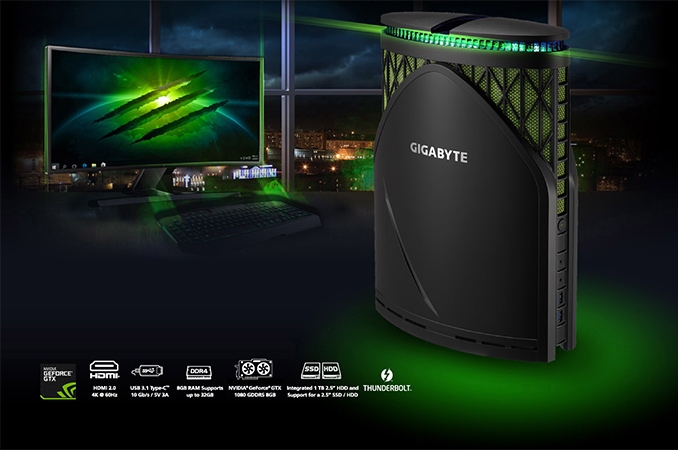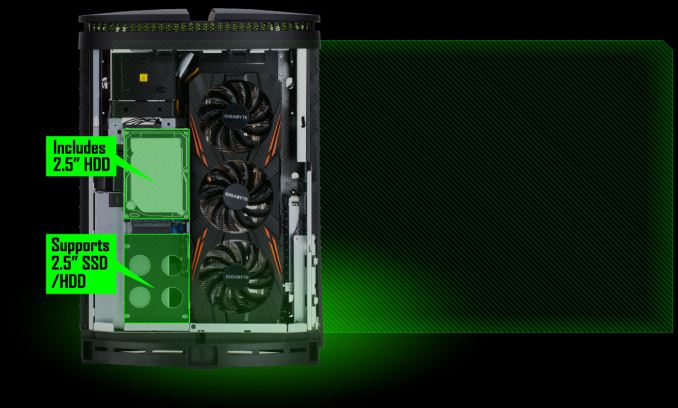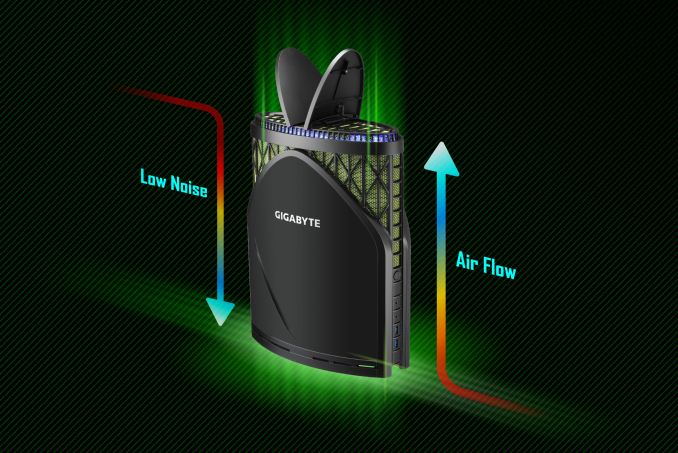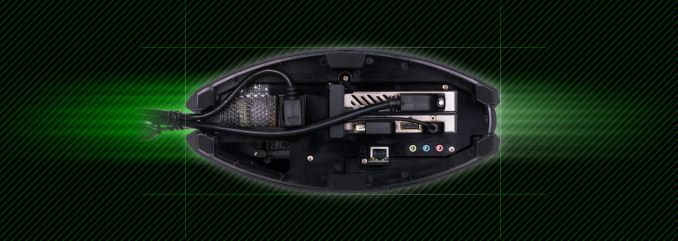GIGABYTE's New Console: The 'Gaming GT' PC Launched with Core i7-K, GTX1080, TB3
by Anton Shilov on December 30, 2016 4:00 PM EST
GIGABYTE has quietly announced its new small form-factor computer designed for performance-minded gamers. The new SFF PC not only packs high-performance components, such as the latest-generation CPU and GPU, but it uses desktop-class components and could be upgradeable.
High-performance PCs in small form-factor are not rare nowadays: various PC makers use mobile CPUs and GPUs to build such systems. Such computers demonstrate high-performance out-of-the-box, but their upgrade strategy is tricky because it is not easy to get MXM GPUs or mobile CPUs in retail. When developing the GIGABYTE Gaming GT desktop (GB-GZ1DTi7-1080-OK-GW and technically this PC belongs to the Brix family), engineers from GIGABYTE wanted to create a product that could use widely available processors and graphics cards and thus potentially offer an upgrade path to the owners.
The GIGABYTE Gaming GT desktop is not really a miniature system: it measures 276×384×128 mm and is approximately 10 liters in volume, which makes it just larger than Sony’s first-generation PlayStation 3. The PC is based on a custom motherboard (210×205 mm) that is a bit larger than Mini-ITX, but is still smaller when compared to microATX or FlexATX. The system uses a dual-chamber design (CPU, DRAM, SSD are located on one side of the PC, graphics card and other 2.5” storage devices are on the other side), but the chambers are not isolated completely because they use the same airflows generated by two system fans (we do not know how large they are, but theoretically they may be of 90 mm in diameter). It is noteworthy that the PC has an automated exhaust system that opens up exhaust flippers at the top of the computer when it needs to cool down the components.
The chassis can accommodate any double wide graphics card with a maximum size of 280 mm in length and 41 mm in depth, but nothing too custom with regards heatpipes and backplates because the space is constrained. GIGABYTE will ship the Gaming GT desktop with its own GeForce GTX 1080 G1 Gaming 8 GB card, but they say the key thing is that it can be updated later. Since the card faces downwards, it has to use custom cables (bundled) to connect to displays. Audio and Ethernet cables also have to be angled, but at least it is not a big problem to find such cables in retail. On the bright side of things, the Gaming GT desktop uses a 400 W FlexATX PSU, which could be upgraded if needed.
| GIGABYTE Gaming GT Spefications | |
| GB-GZ1DTi7-1080-OK-GW | |
| CPU | Intel Core i7-6700K Quad Core with HT 4.0 GHz/4.2 GHz 91 W |
| PCH | Intel Z170 |
| Graphics | GIGABYTE GeForce GTX 1080 G1 Gaming 8 GB GDDR5X 2560 stream processors 160 texture units 64 raster operations pipelines |
| Memory | 32 GB of DDR4 (2×16 GB DDR4) |
| Storage | 240 GB SSD (PCIe/SATA?) 1 TB 2.5" HDD (7200 RPM) 1×2.5" bay for HDD/SSD (SATA) |
| Wi-Fi | Intel 1×1 Dual Band Wireless-AC 3165NGW 802.11ac + BT |
| Ethernet | Rivet Networks Killer E2400 Gigabit LAN |
| Display Outputs | 1 × DVI-D DL 1 × HDMI 2.0b 1 × HDMI 1.4 (uses iGPU) 3 × DisplayPort 1.4 |
| Audio | 5.1-channel audio Realtek ALC1150 codec TI Burr Brown OPA2134 operational amplifier |
| USB | 5 × USB 3.0 Type-A (5 Gbps) 1 × USB 3.1 Type-A (10 Gbps) 1 × Thunderbolt 3/USB 3.1 Type-C (10 Gbps) |
| Other I/O | - |
| Dimensions | 276 mm × 384 mm × 128 mm 10.86 × 15.11 × 5 inches |
| PSU | FlexATX 400 W |
| OS | Windows 10 Home |
The custom motherboard of the GIGABYTE Gaming GT PC is based on the Intel Z170 PCH and thus supports all LGA1151 processors, including the upcoming Kaby Lake chips. The manufacturer will ship the system with the Intel Core i7-6700K CPU (so, overclocking seems to be possible, but keep in mind temperatures and noise), but eventually the chip might be switched to something more powerful.

The GIGABYTE Gaming GT PC will come with 32 GB of dual-channel DDR4 memory, a 240 GB SSD (M.2 form-factor, but no word on performance), a 1 TB HDD with a 7200 RPM spindle speed and an additional 2.5” bay for an extra drive. For those, who are not satisfied with an M.2 SSD and two 2.5” HDDs/SSDs, GIGABYTE even installed one Thunderbolt 3 port to connect external high-performance storage devices or special-purpose hardware. When it comes to other I/O, then the Gaming GT desktop offers a dual-band 1×1 802.11ac + BT 4.2 wireless module, Gigabit Ethernet (Killer E2400), five USB 3.0 Type-A ports, one USB 3.1 Type-A (10 Gbps) port, 5.1-channel audio (the Realtek ALC1150 with the TI Burr Brown OPA2134 amplifier) and so on.
Finally, to give its Gaming GT system a distinctive look, GIGABYTE installed a series of RGB LEDs on top of it. The LEDs can work in different modes and can be controlled using the company’s Ambient LED application.
Pricing and availability dates for the GIGABYTE Gaming GT SFF PCs were not available at press time. Keep in mind that actual configuration of the PC will differ based on the regions, which means that their prices will vary as well. Chances are we'll see it at CES next week.
Related Reading:
- Zotac ZBOX MAGNUS EN1080 SFF PC Review: A Premium Gaming Powerhouse
- GIGABYTE Updates The Aero 14 Thin Gaming Laptop: Now with a GeForce GTX 1060 GPU
- Calyos NSG Cube: Passively Cooled SFF PC with Intel Core and GeForce GTX 1060
- ZOTAC ZBOX MAGNUS ERX480: SFF PC with Intel Core i5, AMD Radeon RX480, USB-C
Source: GIGABYTE


















42 Comments
View All Comments
Einy0 - Saturday, December 31, 2016 - link
That is your complaint? The Killer NIC will be just fine. The bigger issue is the 1:1 802.11AC. I don't get it, fill it up with premium hardware and top it off with bargain basement wifi! Granted, not everyone will use the wifi but holy crap at least spring for a 2:2 card.wintermute000 - Monday, January 2, 2017 - link
I agree, I think a more balanced configuration would be with a 2x2 AC card, 16Gb RAM and a choice of 1060 up to 1080. I'd be leery of a 1080 in that confined space TBHChaser - Saturday, December 31, 2016 - link
Anand did a review of the Killer NIC like within a year ago. They were so impressed with it they made a strong recommendation for it compared to others.Fratman - Friday, December 30, 2016 - link
This design and configuration looks pretty good overall. I would prefer a higher wattage power supply, maybe 650 watts.I suspect the 240 GB SSD is weak. And why even bother with a HDD? I would prefer something like a Samsung 960 Evo M.2 NVMe paired with a Samsung 850 Evo SATA drive.
Teizo - Friday, December 30, 2016 - link
Well, as expensive as this unit is going to be I think they are to try to at least keep it somewhat reasonable. Just about all ssds these days so 540/500 just fine which is ample for most scenarios. I do agree with others that a 500 watt PSU would be better, but that appears to be an 80 Plus Gold rated PSU so 400 watts should be fine.DanNeely - Friday, December 30, 2016 - link
The HDD is probably a cost/storage capacity tradeoff. 256+1tb is about the same price as just a 512gb SSD in m.2, and about $100 cheaper than a 1tb SSD. For a gaming system 500gigs is a somewhat marginal capacity, good enough for today but questionable over the next 2 or 3 years. OTOH for anyone able to do manual disk management 256+1tb, will mean you can still keep your main AAA of the month on flash even when they bloat over 100GB each.That said, I hope this is just a single model on the platform and that higher end variants with pure flash storage are available.
ChefJeff789 - Friday, December 30, 2016 - link
The exhaust flippers make most locations I would put an SFF PC inconvenient at best. Plus, I don't want more systems that can fail in my PC, I want less.DroidTomTom - Sunday, January 1, 2017 - link
If that is the case then just remove them completely. I believe they are opened by the air pressure of the cooling fans so not really anything additional to fail except for them getting stuck.lazarpandar - Monday, January 2, 2017 - link
What makes you believe this? Cooling fans produce a surprisingly low amount of air pressure.Manch - Tuesday, January 3, 2017 - link
I have a Zalman case that opens vents at the top when it hits a temperature threshold. There's a motor that runs it. Air pressure wouldn't be enough. I quite like it. It helps with the dust. and cuts the noise down when not gaming.